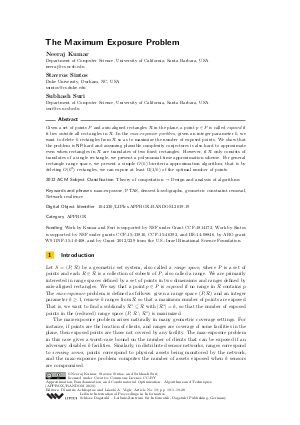The Maximum Exposure Problem
Authors Neeraj Kumar, Stavros Sintos, Subhash Suri
-
Part of:
Volume:
Approximation, Randomization, and Combinatorial Optimization. Algorithms and Techniques (APPROX/RANDOM 2019)
Part of: Series: Leibniz International Proceedings in Informatics (LIPIcs)
Part of: Conference: International Conference on Randomization and Computation (RANDOM)
Part of: Conference: International Conference on Approximation Algorithms for Combinatorial Optimization Problems (APPROX) - License:
 Creative Commons Attribution 3.0 Unported license
Creative Commons Attribution 3.0 Unported license
- Publication Date: 2019-09-17
File

PDF
LIPIcs.APPROX-RANDOM.2019.19.pdf
- Filesize: 0.72 MB
- 20 pages
Document Identifiers
Subject Classification
ACM Subject Classification
- Theory of computation → Design and analysis of algorithms
Keywords
- max-exposure
- PTAS
- densest k-subgraphs
- geometric constraint removal
- Network resilience
Metrics
- Access Statistics
-
Total Accesses (updated on a weekly basis)
0Document
0Metadata
Abstract
Given a set of points P and axis-aligned rectangles R in the plane, a point p in P is called exposed if it lies outside all rectangles in R. In the max-exposure problem, given an integer parameter k, we want to delete k rectangles from R so as to maximize the number of exposed points. We show that the problem is NP-hard and assuming plausible complexity conjectures is also hard to approximate even when rectangles in R are translates of two fixed rectangles. However, if R only consists of translates of a single rectangle, we present a polynomial-time approximation scheme. For general rectangle range space, we present a simple O(k) bicriteria approximation algorithm; that is by deleting O(k^2) rectangles, we can expose at least Omega(1/k) of the optimal number of points.
Cite As Get BibTex
Neeraj Kumar, Stavros Sintos, and Subhash Suri. The Maximum Exposure Problem. In Approximation, Randomization, and Combinatorial Optimization. Algorithms and Techniques (APPROX/RANDOM 2019). Leibniz International Proceedings in Informatics (LIPIcs), Volume 145, pp. 19:1-19:20, Schloss Dagstuhl – Leibniz-Zentrum für Informatik (2019)
https://doi.org/10.4230/LIPIcs.APPROX-RANDOM.2019.19
BibTex
@InProceedings{kumar_et_al:LIPIcs.APPROX-RANDOM.2019.19,
author = {Kumar, Neeraj and Sintos, Stavros and Suri, Subhash},
title = {{The Maximum Exposure Problem}},
booktitle = {Approximation, Randomization, and Combinatorial Optimization. Algorithms and Techniques (APPROX/RANDOM 2019)},
pages = {19:1--19:20},
series = {Leibniz International Proceedings in Informatics (LIPIcs)},
ISBN = {978-3-95977-125-2},
ISSN = {1868-8969},
year = {2019},
volume = {145},
editor = {Achlioptas, Dimitris and V\'{e}gh, L\'{a}szl\'{o} A.},
publisher = {Schloss Dagstuhl -- Leibniz-Zentrum f{\"u}r Informatik},
address = {Dagstuhl, Germany},
URL = {https://drops.dagstuhl.de/entities/document/10.4230/LIPIcs.APPROX-RANDOM.2019.19},
URN = {urn:nbn:de:0030-drops-112344},
doi = {10.4230/LIPIcs.APPROX-RANDOM.2019.19},
annote = {Keywords: max-exposure, PTAS, densest k-subgraphs, geometric constraint removal, Network resilience}
}
Author Details
Funding
Work by Kumar and Suri is supported by NSF under Grant CCF-1814172. Work by Sintos is supported by NSF under grants CCF-15-13816, CCF-15-46392, and IIS-14-08846, by ARO grant W911NF-15-1-0408, and by Grant 2012/229 from the U.S.-Israel Binational Science Foundation.
References
-
P. K Agarwal and J. Pan. Near-linear algorithms for geometric hitting sets and set covers. In Proceedings of 30th SoCG, page 271. ACM, 2014.

-
S. Arora, D. Karger, and M. Karpinski. Polynomial time approximation schemes for dense instances of NP-hard problems. Journal of computer and system sciences, 58(1):193-210, 1999.

-
Y. Asahiro, K. Iwama, H. Tamaki, and T. Tokuyama. Greedily finding a dense subgraph. Journal of Algorithms, 34(2):203-221, 2000.

-
S. Bandyapadhyay, N. Kumar, S. Suri, and K. Varadarajan. Improved Approximation Bounds for the Minimum Constraint Removal Problem. In Proceedings of 21st APPROX, pages 2:1-2:19, 2018.

-
S. Bereg and D. G. Kirkpatrick. Approximating Barrier Resilience in Wireless Sensor Networks. In Proceedings of 5th ALGOSENSORS, pages 29-40, 2009.

-
A. Bhaskara, M. Charikar, E. Chlamtac, U. Feige, and A. Vijayaraghavan. Detecting high log-densities: an O (n^1/4) approximation for densest k-subgraph. In Proceedings of the 42nd STOC, pages 201-210. ACM, 2010.

-
H. Brönnimann and M. T. Goodrich. Almost optimal set covers in finite VC-dimension. Discrete & Computational Geometry, 14(4):463-479, 1995.

-
C. Chekuri, K. L. Clarkson, and S. Har-Peled. On the set multi-cover problem in geometric settings. ACM Transactions on Algorithms (TALG), 9(1):9, 2012.

-
E. Chlamtac, M. Dinitz, C. Konrad, G. Kortsarz, and G. Rabanca. The Densest k-Subhypergraph Problem. In Proceedings of 19th APPROX, pages 6:1-6:19, 2016.

-
E. Chlamtáč, M. Dinitz, and Y. Makarychev. Minimizing the union: Tight approximations for small set bipartite vertex expansion. In Proceedings of the 28th SODA, pages 881-899, 2017.

-
K. L. Clarkson and P. W. Shor. Application of Random Sampling in Computational Geometry, II. Discrete & Computational Geometry, 4:387-421, 1989.

-
M. Cygan, F. Grandoni, S. Leonardi, M. Mucha, M. Pilipczuk, and P. Sankowski. Approximation Algorithms for Union and Intersection Covering Problems. In Proceedings of 31st FSTTCS, page 28, 2011.

-
E. Eiben, J. Gemmell, I. Kanj, and A. Youngdahl. Improved results for minimum constraint removal. In Proceedings of 32nd AAAI Conference on Artificial Intelligence, 2018.

-
U. Feige. A threshold of ln n for approximating set cover. Journal of the ACM (JACM), 45(4):634-652, 1998.

-
U. Feige, D. Peleg, and G. Kortsarz. The dense k-subgraph problem. Algorithmica, 29(3):410-421, 2001.

-
U. Feige and M. Seltser. On the Densest K-subgraph Problems. Technical report, Weizmann Institute of Science, Jerusalem, Israel, 1997.

-
R. J. Fowler, M. S. Paterson, and S. L. Tanimoto. Optimal packing and covering in the plane are NP-complete. Information processing letters, 12(3):133-137, 1981.

-
D. S. Hochbaum and W Maass. Approximation schemes for covering and packing problems in image processing and VLSI. Journal of the ACM (JACM), 32(1):130-136, 1985.

-
M. Korman, M. Löffler, R. I. Silveira, and D. Strash. On the complexity of barrier resilience for fat regions and bounded ply. Comput. Geom., 72:34-51, 2018.

-
N. H. Mustafa, R. Raman, and S. Ray. Settling the APX-hardness status for geometric set cover. In Proceedings of 55th FOCS, pages 541-550. IEEE, 2014.

